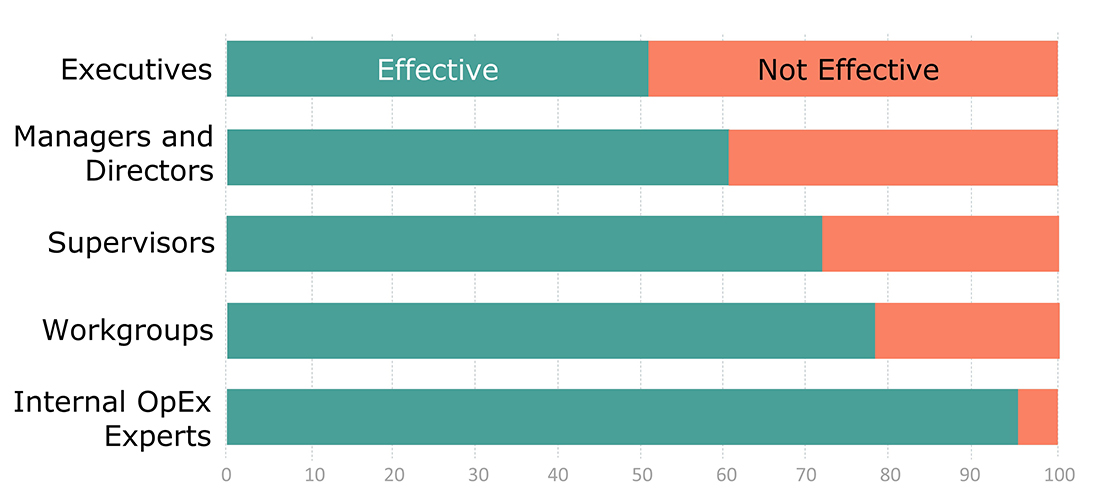When it comes to implementing any new initiative, communication is a critical success factor. A full menu of changes; some large and sweeping, some small but critical, will be generated by and with people in the organization over the course of the effort. How leadership chooses to broadly communicate these changes ― all together, in small or large portions, or one-on-one, can make a huge difference in the rate of adoption. It’s important to carefully consider how, when, why, what and where information / updates will be presented to fully engage employees and, ultimately, drive sustainable improvements.
The way information is communicated to employees during times of change has a tremendous impact on the final results. If handled ineffectively, morale and productivity decreases ― despite the best of intentions. When there are looming questions and concerns, they lose faith. If employees don’t receive enough information, speculation and rumor can become truth. In the end, a disengaged workforce emerges,  resulting in reduced effort and commitment just when their dedication is needed the most. How do you stop or prevent this from happening?
resulting in reduced effort and commitment just when their dedication is needed the most. How do you stop or prevent this from happening?
Leadership should consider these 10 ideas when planning for, announcing, implementing, and communicating Lean transformation activities:
1. Get Qualified Communicators Involved
It’s important for organizations to get their internal communications team involved from the very beginning. Too often, qualified communicators are involved after a backlash is in full force ― when leaks and rumors are rampant. CFOs and COOs are not typically qualified to understand how employees will respond to change and how best to share information. On the other hand, qualified internal communications professionals typically have proven expertise in change management, crisis communications, executive communications, etc. They need to have a seat at the leadership table.
2. Establish a Communications Plan
Don’t confuse process (e.g., visioning, chartering executive steering committees, planning, endless PowerPoint presentations, etc.) with communication. While those meetings and processes can be communication vehicles if designed mindfully and handled in the context of a broader program, they aren’t adequate to meet all communication needs.
3. Communicate Early
Once a plan and timeline has been developed based on the initiative strategy, start communicating. The longer employees have to wrap their heads around change, the better they tend to accept it. At the beginning of the change:
- Communicate employee benefits first ― starting with “how this change helps the organization” can create a sense of injustice, so focus on employees first;
- Identify why the change is necessary and what will happen if there is no change;
- Explain how the changes fit into the overall business strategy and the organization’s priorities;
- Review the process, including what will be done to involve everyone in it;
- Discuss timing and when they will get more information.
4. Communicate Often
Update employees regularly to share victories and address pending issues. When employees are communicated with frequently, they are more likely to support the change for the long-term. Information can and should also be repeated (through multiple channels), as research shows that most people have to hear something several times before they fully process the message.
5. Use Multiple Communication Channels
Some organizations make the mistake of using only one vehicle, such as e-mail or signage, to communicate changes. Considering not every employee digests information the same way, and that there are so many options to choose from, organizations that leverage a multi-channel approach ― combining email, intranet, social chat rooms, newsletters, presentations, face-to-face meetings, conference calls, etc. ― have more success.
6. Prepare Spokespeople
Leadership does not only need to understand how to explain the transformation, they need to understand when they should and should not be the ones to speak about it. They need to know how to keep things positive. They also need to be able to drill down and explain what change means to various audiences. Keeping them in sync is critical.
7. Test Your Communications
It is often useful to test out messaging on a subset of stakeholders, especially when there’s time to do so. Testing can be done through focus groups, employee surveys, or a more informal round-table where individuals can practice delivering the message and get first-hand feedback.
8. Provide Ample Opportunities to Share Feedback
Giving employees multiple opportunities to share concerns, ask questions, and offer ideas is crucial to the process. The more two-way communication is made a priority, the better the organization can keep its finger on the pulse of what future communications need to include to meet the needs of the audience.
9. Make Change Part of Day-To-Day Work
To get employees to fully embrace change, a management system, like Kaufman Global’s Lean Daily Management System® (LDMS®), should be put into place to drive day-to-day focus. LDMS helps visualize activities and promote active communication about the work of individual teams every day. It:
- Supports and reinforces clarity of purpose at all levels of the organization;
- Builds continuous improvement and disciplined execution into day-to-day work;
- Involves and develops people;
- Creates a culture of collaboration and accountability.
10. Become a Role Model
People judge the performance of leaders not by what they say but by what they do. Employees will watch closely to determine how leadership is feeling about the change and will draw their own conclusions based on that behavior. Leaders should:
- Convey that they are personally committed to the changes by active participation and sponsorship;
- Be open to discussion with employees regarding the changes;
- Express confidence in the team’s ability to make it through the changes;
- Seek and incorporate input to make the changes work.


 resulting in reduced effort and commitment just when their dedication is needed the most. How do you stop or prevent this from happening?
resulting in reduced effort and commitment just when their dedication is needed the most. How do you stop or prevent this from happening?